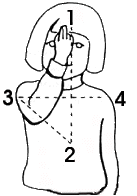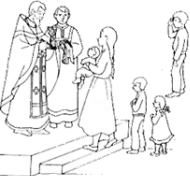Eastern Church Visitor Guide
Glory to Jesus Christ! Glory Forever! This simple guide is for those unfamiliar with the worship of the Eastern Church, and who plan on visiting an Eastern Church in the future.Sign of the Cross.
 To say that we make the sign of the Cross frequently would be an
understatement. We sign ourselves whenever the Trinity is invoked, whenever
we venerate the Cross or an Icon, and on many other occasions in the course
of the Liturgy. But people aren't expected to do everything the same way.
Some people Cross themselves three times in a row, and some finish by
sweeping their right hand to the floor. On first entering a Church people
may come up to an Icon, make a"metania";crossing themselves and bowing with
right hand to the floor wice, then kiss the Icon, then make one more
metania. This becomes familiar with time, but at first it can seem like
secret-handshake stuff that you are sure to get wrong. Don't worry, you
don't have to follow suit.
To say that we make the sign of the Cross frequently would be an
understatement. We sign ourselves whenever the Trinity is invoked, whenever
we venerate the Cross or an Icon, and on many other occasions in the course
of the Liturgy. But people aren't expected to do everything the same way.
Some people Cross themselves three times in a row, and some finish by
sweeping their right hand to the floor. On first entering a Church people
may come up to an Icon, make a"metania";crossing themselves and bowing with
right hand to the floor wice, then kiss the Icon, then make one more
metania. This becomes familiar with time, but at first it can seem like
secret-handshake stuff that you are sure to get wrong. Don't worry, you
don't have to follow suit.

We cross with our right hands from right to left (push, not pull), the
opposite of Roman Catholics and high-Church Protestants. We hold our hands
in a prescribed way: thumb and first two fingertips pressed together, last
two fingers pressed down to the palm (Three fingers together for the
Trinity; two fingers brought down to the palm for the two natures of Christ,
and his coming down to earth.) This, too, takes practice. .
Singing
About seventy-five percent of the service is congregational singing. The
cantor (or small choir) leads the people in a cappella harmony, with the
level of congregational response varying from parish to parish. It has been
fairly said that the Liturgy is one continuous song. What keeps this from
being exhausting is that it's pretty much the *same* song every week.
Relatively little changes from Sunday to Sunday; the same prayers and hymns
appear in the same places, and before long you know it by heart.
The Holy Theotokos and the Saints
A constant feature of our worship is the veneration of the Virgin Mary. We
often address her as"Theotokos,' which means"birth-giver of God.' In
providing the physical means for God to become man, she made possible our
salvation.
But though we honor her, as Scripture foretold ('All generations will call
me blessed,' Luke 1:48), this doesn't mean that we think she or any of the
other saints have magical powers or are demi-gods. When we sing"Holy
Theotokos, save us,' we don't mean that she grants us eternal salvation, but
that we seek her prayers for our protection and growth in faith. Just as we
ask for each other's prayers, we ask for the prayers of Mary and other
saints as well. They're not dead, after all, just departed to the other
side. Icons surround us to remind us of all the saints who are joining us
invisibly in worship.
Icon Screen
Most Eastern Churches will have an Iconostasis before its altar.
'Iconostasis' means"Icon-stand', and
it can be as simple as a large image of Christ on the right and a
corresponding image of the Virgin and Child on the left. In a more
established Church, the Iconostasis may be a literal wall, adorned with
Icons. Some versions shield the altar from view, except when the
central doors stand open.
The basic set-up of two large Icons creates, if you use your imagination,
three doors. The central one, in front of the altar itself, is called the
'Holy Doors' or"Royal Doors,' because there the King of Glory comes out to
the congregation in the Eucharist. Only the priest and deacons, who bear the
Eucharist, use the Holy Doors. The openings on the other sides of the Icons,
if there is a complete Iconostasis, have doors with Icons of angels; they
are termed the"Deacon's Doors.'
Receiving Communion in the East
All Catholics (Eastern and Western) in good standing, who are properly
 prepared
(prayer and fasting) are invited to receive communion. In the Byzantine
Tradition, the Mystery of
the
Holy Eucharist involves the use of leavened bread, out of which is cut one
major particle, a square"Lamb of God' that bears the imprint IC XC NIKA
(Jesus Christ Conquers) on it. Out of this Lamb is cut the many particles
that will be consecrated and placed into the holy paterion (chalice or cup)
containing the consecrated wine. When the faithful approach the Holy
Mysteries, they traditionally make the sign of the Cross at a safe distance
from the chalice, not while standing directly in front of the priest (or
deacon). As you approach, fold your arms in the Cross of Saint Andrew (X)
across your chest. Please move in as close as possible to the paten that is
being held by the altar server. The priest/deacon will then recite,"The
servant/handmaid of God, (name), receives the most precious and holy Body
and Blood of our
prepared
(prayer and fasting) are invited to receive communion. In the Byzantine
Tradition, the Mystery of
the
Holy Eucharist involves the use of leavened bread, out of which is cut one
major particle, a square"Lamb of God' that bears the imprint IC XC NIKA
(Jesus Christ Conquers) on it. Out of this Lamb is cut the many particles
that will be consecrated and placed into the holy paterion (chalice or cup)
containing the consecrated wine. When the faithful approach the Holy
Mysteries, they traditionally make the sign of the Cross at a safe distance
from the chalice, not while standing directly in front of the priest (or
deacon). As you approach, fold your arms in the Cross of Saint Andrew (X)
across your chest. Please move in as close as possible to the paten that is
being held by the altar server. The priest/deacon will then recite,"The
servant/handmaid of God, (name), receives the most precious and holy Body
and Blood of our
